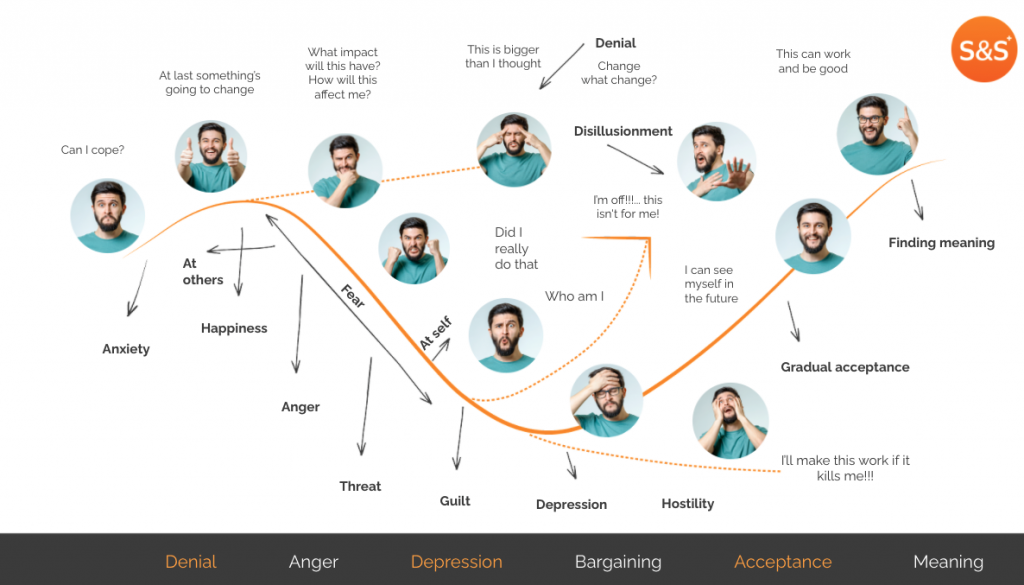Elisabeth Kübler-Ross developed a model describing the five common stages of grief: denial, anger, depression, bargaining, and acceptance. However, we go through these same stages with any change in our lives. The Change Curve (based on Kübler-Ross’s work) is often used to describe the emotions experienced by the majority of people responding to any kind of change.
For example, when we move jobs:
Denial: you may feel fear, “What if my new team doesn’t accept me?”, or avoidance, “I won’t say anything about my new job until all the paperwork is sorted.”
Anger: you may feel frustration, “Why didn’t my current company fight to keep me?”, or anxiety, “Is this the right decision?”
Depression: you may feel overwhelmed, “I have so much to learn before I can be useful”, or you may feel the ‘flight’ response, “I’m just not ready to start from scratch in a new role”.
Bargaining: you may feel the need to reach out to others, “I’m feeling a bit nervous, do you fancy a coffee?”, or to tell your story, “I’ve worked really hard to get to this point in my career and deserve this next step”.
Acceptance: you may start to put a plan in place, “On my first day I’ll make a point of learning everyone’s names and having lunch with the team”, and decide that it’s time to move on, “I have enjoyed working for company ABC Ltd, but I’m ready for something new.”

But while the model describes the emotions in stages, people don’t experience them in a linear fashion. In reality, every change is different and affects people in different ways, meaning we often move up and down the curve, repeating different stages before we come to acceptance. Our aim as leaders of change is to help people minimise the intensity of the emotions and to move quickly through the Change Curve.
What is lesser known about the Kübler-Ross 5 stages of grief model, is that David Kessler added a sixth stage (after her death and with the support of her family). Kessler believes that acceptance isn’t the last emotion people feel in relation to grief, it’s finding meaning. And this is equally important for all change we experience. Whatever the outcome, closure is found once people have accepted and then started to find meaning from it.

How we can help people on their journey through the Change Curve
Change (whether good or bad) feels hard, no matter how many times we’ve experienced it before. By understanding each stage, you can help your business become ChangeReady and minimise the peaks and troughs on the journey to success.
Strong leadership overcomes denial and anger
The best leaders of change share five key traits:
- They provide clarity and direction.
- They engage and inspire teams.
- They actively listen to teams and provide feedback.
- They create outcome oriented, cross functional teams.
- They embed change as a constant.
Excited about the future, and feeling able to contribute to it, people start to feel more resilient and better equipped to deal with continuous change. They can sustain good levels of energy, as well as positive mental health and well-being, despite the constant focus on delivery.
Provide context to overcome fear
Framing change helps people to see that not everything is in flux. When people can contextualise a change it helps them to understand that a lot of their environment remains the same. Sorting each part of what is perceived as changing into these groups can help:
- Business as usual activities: things you could/couldn’t do before and still can/can’t do.
- Activities to stop: things you will no longer be able to do (or don’t want to do) so you let them go.
- Activities to start: things you couldn’t do before but now have the opportunity to explore.
Help people to see how they contribute to the new world and move towards accepting the change.
When we talk to clients, we work through how important it is to explain ‘why’ the change is necessary and what is happening. People seek certainty. By understanding the why and the what, they start to understand how change affects them, and therefore gain the certainty they need.
Keep moving forward
So far I’ve talked about the actions we can take to minimise the negative emotions associated with change. Getting on with doing things makes us feel that we are helping. Undoubtedly the activities above will help to reduce the extremes of negative emotions and reduce the amount of time we feel them for.
However this ‘busy-ness’ only gets us so far. We also need to remember that ‘time is a great healer’ and giving people time will help them to process, reflect and naturally move to acceptance and finding meaning.
Want to know more about how S&S can help you and your organisation?
- Sign up for our fortnightly newsletter The Pulse with cutting edge business insights from our experts.
- If you’re a senior leader or change agent, join one of our change communities to network and share with like-minded individuals.
- If you have a problem that needs solving across business change, agility, leadership or transformation and you don’t want to go down the big, traditional consulting route- Get in touch





































































